cruise control CITROEN RELAY 2017 Handbook (in English)
[x] Cancel search | Manufacturer: CITROEN, Model Year: 2017, Model line: RELAY, Model: CITROEN RELAY 2017Pages: 292, PDF Size: 9.04 MB
Page 4 of 292
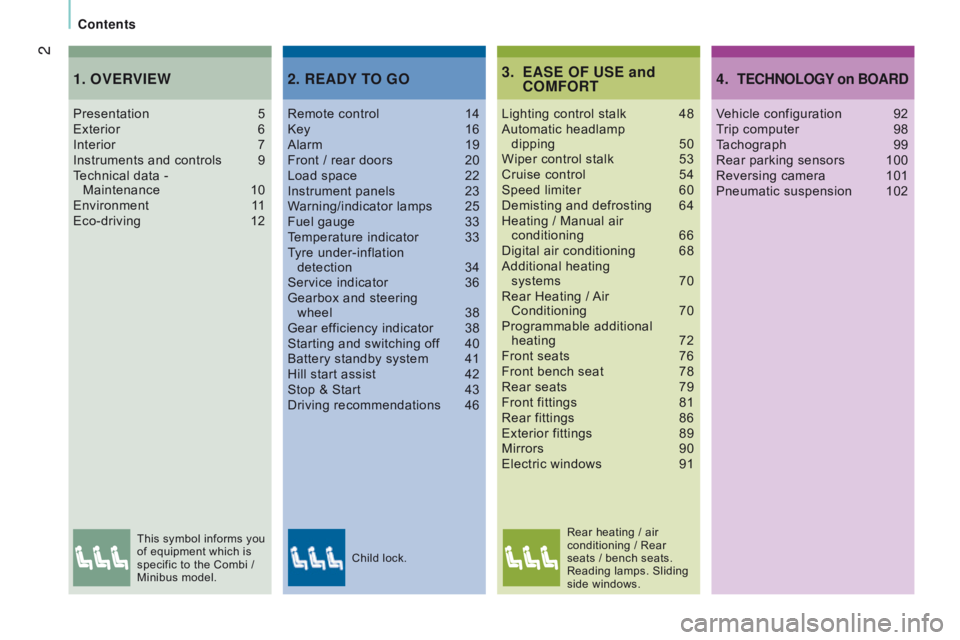
2
contents
3. EASE OF u SE and c
OMFO rt
Lighting control stalk 48
Automatic headlamp
dipping
50
Wiper control stalk
53
Cruise control
54
Speed limiter
60
Demisting and defrosting
64
Heating / Manual air
conditioning
66
Digital air conditioning
68
Additional heating
systems
70
Rear Heating /
Air
Conditioning
70
Programmable additional
heating
72
Front seats
76
Front bench seat
78
Rear seats
79
Front fittings
81
Rear fittings
86
Exterior fittings
89
Mirrors
90
Electric windows
91
Presentation
5
Exterior
6
Interior
7
Instruments and controls
9
T
echnical data -
Maintenance
10
Environment
1
1
Eco-driving
12
1. OVErVIEW 4. tEcHnOLOGY on BOArd
Vehicle configuration 92
T rip computer 98
T
achograph
99
Rear parking sensors
100
Reversing camera
101
Pneumatic suspension
102
2. rEAdY tO GO
Remote control 14
Key 16
Alarm
19
Front
/ rear doors
20
Load space
22
Instrument panels
23
W
arning/indicator lamps
25
Fuel gauge
33
T
emperature indicator
33
T
yre under-inflation
detection
34
Service indicator
36
Gearbox and steering
wheel
38
Gear ef
ficiency indicator
38
Starting and switching of
f
40
Battery standby system
41
Hill start assist
42
Stop & Start
43
Driving recommendations
46
This symbol informs you
of equipment which is
specific to the Combi /
Minibus model. Child lock.Rear heating / air
conditioning / Rear
seats / bench seats.
Reading lamps. Sliding
side windows.
Page 7 of 292
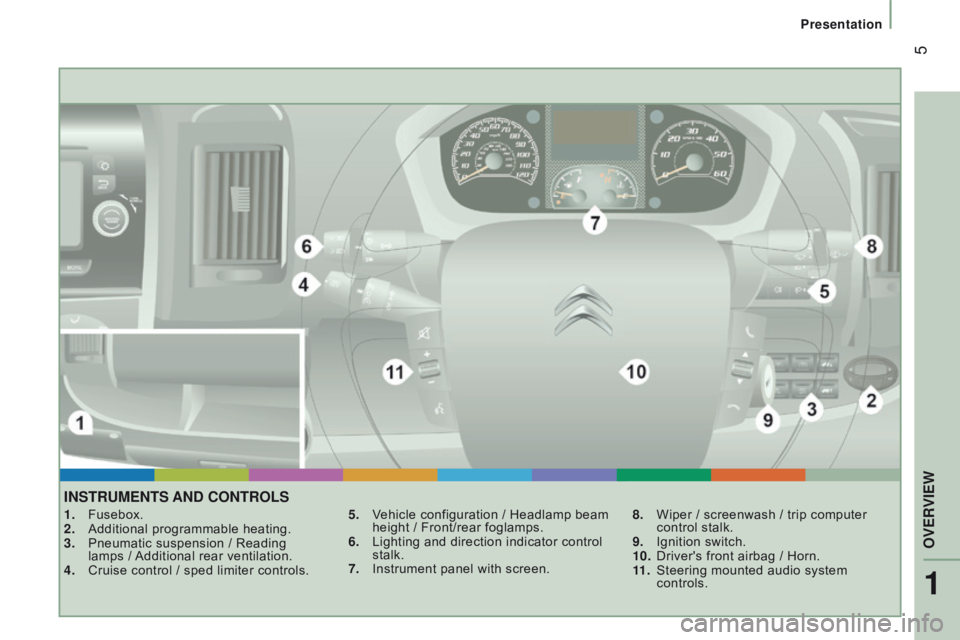
5
InStruMEntS And cOntrOLS
1. Fusebox.
2. Additional programmable heating.
3.
Pneumatic suspension / Reading
lamps
/ Additional rear ventilation.
4.
Cruise control / sped limiter controls. 5.
V ehicle configuration / Headlamp beam
height / Front/rear foglamps.
6.
Lighting and direction indicator control
stalk.
7.
Instrument panel with screen.8.
Wiper / screenwash / trip computer
control stalk.
9.
Ignition switch.
10.
Driver's front airbag / Horn.
11
.
Steering mounted audio system
controls.
1
OVErVIEW
Presentation
Page 11 of 292
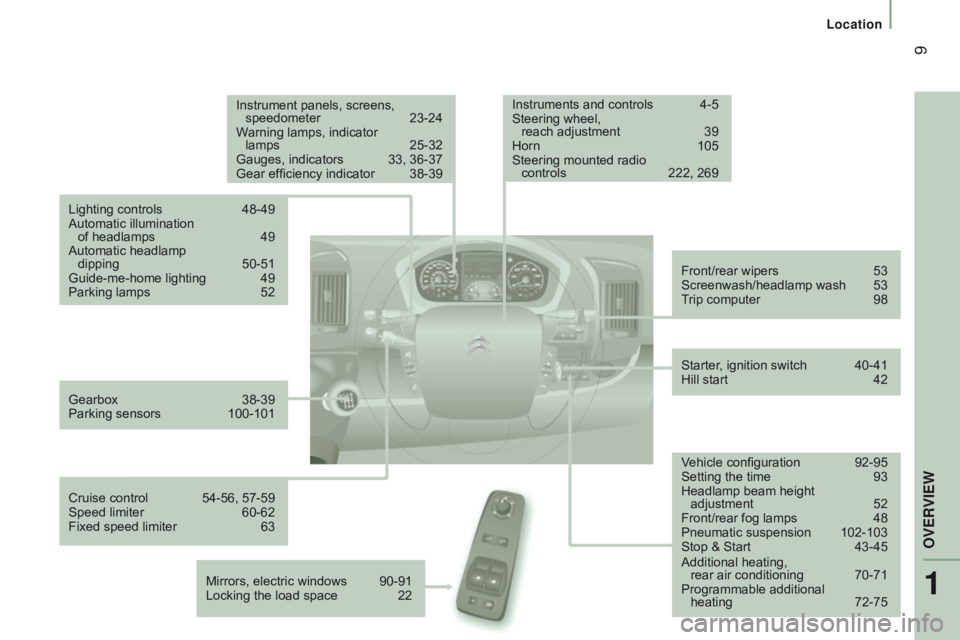
9
Gearbox 38-39
Parking sensors 100-101Instrument panels, screens,
speedometer
23-24
W
arning lamps, indicator
lamps
25-32
Gauges, indicators
33, 36-37
Gear efficiency indicator
38-39
Lighting controls
48-49
Automatic illumination
of headlamps
49
Automatic headlamp
dipping
50-51
Guide-me-home lighting
49
Parking lamps
52
V
ehicle configuration
92-95
Setting the time
93
Headlamp beam height
adjustment
52
Front/rear fog lamps
48
Pneumatic suspension
102-103
Stop & Start
43-45
Front/rear wipers
53
Screenwash/headlamp wash
53
T
rip computer
98
Starter
, ignition switch
40-41
Hill start
42
Cruise control
54-56, 57-59
Speed limiter
60-62
Fixed speed limiter
63 Instruments and controls
4-5
Steering wheel,
reach adjustment
39
Horn
105
Steering mounted radio
controls
222, 269
Mirrors, electric windows
90-91
Locking the load space
22 Additional heating,
rear air conditioning
70-71
Programmable additional
heating
72-75
1
OVERVIEW
Location
Page 14 of 292

12
EcO-drIVInG
Optimise the use of your gearbox
With a manual gearbox, move off gently
and change up without waiting. While
accelerating changing up early. If your
vehicle has the system, the gear efficiency
indicator invites you to engage the most
suitable gear; follow its instructions as
soon as it is displayed in the instrument
panel.
drive smoothly
Maintain a safe distance between vehicles,
use engine braking rather than the
brake pedal, and press the accelerator
progressively. These practices contribute
towards a reduction in fuel consumption
and CO
2 emissions and also helps reduce
the background traffic noise.
If your vehicle has cruise control, make
use of the system at speeds above 20 mph
(30 km/h) when the traffic is flowing well.
control the use of your electrical
equipment
Before moving off, if the passenger
compartment is too warm, ventilate it by
opening the windows and air vents before
using the air conditioning.
Above 30 mph (50 km/h), close the
windows and leave the air vents open.
Remember to make use of equipment
that can help keep the temperature in the
passenger compartment down. Switch off the headlamps and front
foglamps when they are not needed for
safety.
Eco-driving is a range of everyday
practices that allow the motorist to optimise
their fuel consumption and CO
2 emissions.
Avoid running the engine before moving
off, particularly in winter; your vehicle will
warm up much faster while driving.
Disconnect your portable devices before
leaving the vehicle.Switch off the air conditioning, unless it
has automatic digital regulation, as soon
as the desired temperature is attained.
Switch off the demisting and defrosting
controls, if not automatic.
Switch off the heated seat as soon as
possible.
Motoring & the Environment
Page 25 of 292
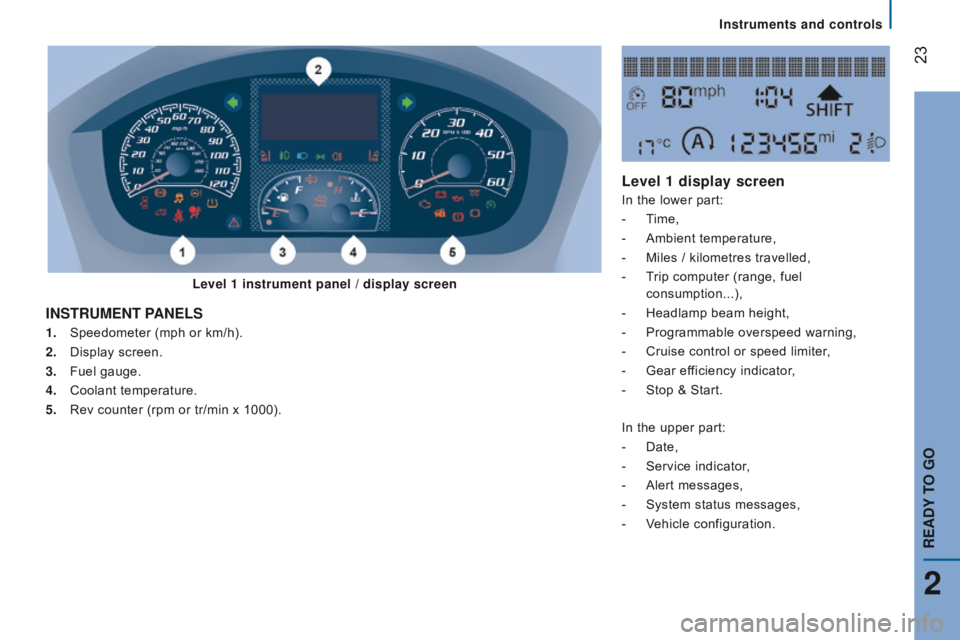
23
1. Speedometer (mph or km/h).
2.
Display screen.
3.
Fuel gauge.
4.
Coolant temperature.
5.
Rev counter (rpm or tr/min x 1000).
InStruMEnt PAnELS
Level 1 display screen
In the lower part:
-
T
ime,
-
Ambient temperature,
-
Miles
/ kilometres travelled,
-
T
rip computer (range, fuel
consumption...),
-
Headlamp beam height,
-
Programmable overspeed warning,
-
Cruise control or speed limiter
,
-
Gear ef
ficiency indicator,
-
Stop & Start.
In the upper part:
-
Date,
-
Service indicator
,
-
Alert messages,
-
System status messages,
-
V
ehicle configuration.
Level 1 instrument panel
/ display screen
2
rEAdY tO GO
Instruments and controls
Page 26 of 292

24
Level 2 display screen
In the left-hand part:
-
T
ime,
-
Ambient temperature,
-
Alert or state indicators,
-
Cruise control or speed limiter
.
In the right-hand part:
-
Date,
-
Service indicator
,
-
T
rip computer (range, fuel
consumption...),
-
Alert messages,
-
Messages on the state of systems,
-
V
ehicle configuration,
-
Headlamp beam height,
-
Miles
/ kilometres travelled.
Level 2 instrument panel
/ display screen
Instruments and controls
Page 32 of 292
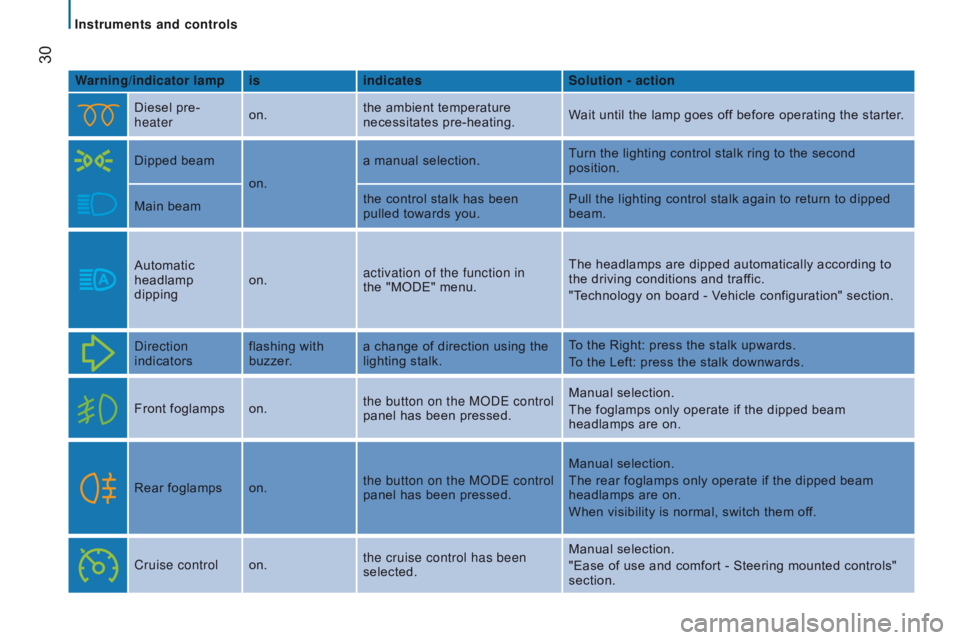
30
Warning/indicator lampisindicates Solution - action
Diesel pre-
heater on.the ambient temperature
necessitates pre-heating. Wait until the lamp goes off before operating the starter.
Dipped beam on.a manual selection.
Turn the lighting control stalk ring to the second
position.
Main beam the control stalk has been
pulled towards you.Pull the lighting control stalk again to return to dipped
beam.
Automatic
headlamp
dipping on.
activation of the function in
the
"MODE" menu.The headlamps are dipped automatically according to
the driving conditions and traffic.
"Technology on board - Vehicle configuration" section.
Direction
indicators flashing with
buzzer.a change of direction using the
lighting stalk. To the Right: press the stalk upwards.
To the Left: press the stalk downwards.
Front foglamps on. the button on the MODE control
panel has been pressed.Manual selection.
The foglamps only operate if the dipped beam
headlamps are on.
Rear foglamps on. the button on the MODE control
panel has been pressed.Manual selection.
The rear foglamps only operate if the dipped beam
headlamps are on.
When visibility is normal, switch them off.
Cruise control on.the cruise control has been
selected. Manual selection.
"Ease of use and comfort - Steering mounted controls"
section.
Instruments and controls
Page 56 of 292

54cruISE cOntrOL
(3
LI tr E H dI E n GI n E )
"This is the speed at which the driver wishes to
travel".
This aid to driving in free-flowing traffic conditions
enables the vehicle to maintain a constant
speed programmed by the driver, except when a
considerable load is carried on a steep gradient.
In order to be programmed or activated,
the vehicle speed must be greater than
approximately 18 mph (30 km/h), with 2nd gear
or higher engaged.
Function selected.
Function deactivated.
If your vehicle is fitted with cruise control,
this is displayed on the instrument panel by
an indicator located in the rev counter.
Steering mounted controls
Page 57 of 292

55
Selecting the function - On
Selecting On switches the function on. A
message appears in the instrument panel
screen to confirm the action.
Programming a speed
Accelerate to the required speed, with 2nd
to 6th gear engaged.
Move the control upwards (+), for
approximately one second, to store this
speed.
Release the pressure on the accelerator
pedal, the vehicle will maintain this speed.
Switching off / deactivating the function
Press the brake or clutch pedal or place
the ring in the OFF position, the indicator
goes
off.
If the dynamic stability control system comes
into operation, the cruise control system is
deactivated temporarily.
-
increase the speed in steps, by means of
brief presses, or continuously by pressing
and holding the control upwards (+ sign),
temporarily exceeding the
programmed speed
When the cruise control is active, it is still
possible to exceed the programmed speed
by depressing the accelerator pedal (to
overtake another vehicle for example).
-
decrease the speed continuously
by pressing and holding the control
downwards (- sign).
restore - rES
To restore the vehicle's
programmed speed (for example
after pressing the brake or clutch
pedal), gradually return to the chosen speed
and press
r ES.
The indicator lamp comes on, the cruise
control function is restored.
changing the programmed speed
while the cruise control is in operation
You can:
3
EASE OF uSE and cOMFOrt
Steering mounted controls
Page 58 of 292

56Good practice
When changing the programmed reference
speed by pressing and holding the control,
take care as the speed may increase or
decrease rapidly.
Do not use the cruise control on slippery
roads or in heavy traffic.
On a steep gradient, the cruise control will
not be able to prevent the vehicle from
exceeding the programmed speed.
The cruise control cannot, in any
circumstances, replace the need to comply
with speed limits or vigilance on the part of
driver.
It is advisable to leave your feet near the
pedals.
To prevent the mat from becoming caught
under the pedals:
-
ensure that the mat is positioned
correctly,
-
never fit one mat on top of another
.
cancelling the programmed speed
When the vehicle stops, after the ignition is
switched off, the system no longer stores
any speed.
Operating fault
In the event of a fault, the system
is switched off and the indicator
goes off.
Contact a CITROËN dealer or a qualified
workshop to have the system checked.
Steering mounted controls